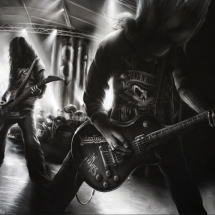

When rock no longer caters to the rhythm
The hustle and bustle on the stage seemed to break free from the established shackles. The distorted guitar sounds no longer intruded into the gaps of the drumbeats in a conventional way. The unrestrained whistling was like a wild horse out of control, galloping recklessly in the dim field. The bass line is no longer an appendage of the rhythm. With its low roar, it is like an undercurrent surging underground, disrupting the originally orderly rhythm. The force and timing of the drumsticks' fall have also broken free from the dogma of "harmony", either sluggish and dragging or sudden and explosive, making the drumbeats the explosive points of emotions rather than the measuring instruments of rhythm.
- 0 followers
- Joined June 2025
- Total events 0
About Us
The singer's voice no longer fits the melodic framework. The hoarse roars and fragmented tail notes interweave with the chaotic playing of the instruments, like a rebellion of sounds. The crowd that once swayed to the rhythm now fell into shock and confusion. Some frowned and left, while others, in this out-of-control sound wave, captured the most genuine rebellion of rock - it no longer caters to the regular rhythm, but instead uses chaos and liberation to shout out its disdain for "how it should be". Turn the stage into a sonic (sound) riot about freedom and confrontation. Even if this chaos will sting the eardrums and shatter the standard of "pleasantness", it will also expose the sharpest and most naked edges of the rock soul at the moment when it deviates from the rhythm's inertia.